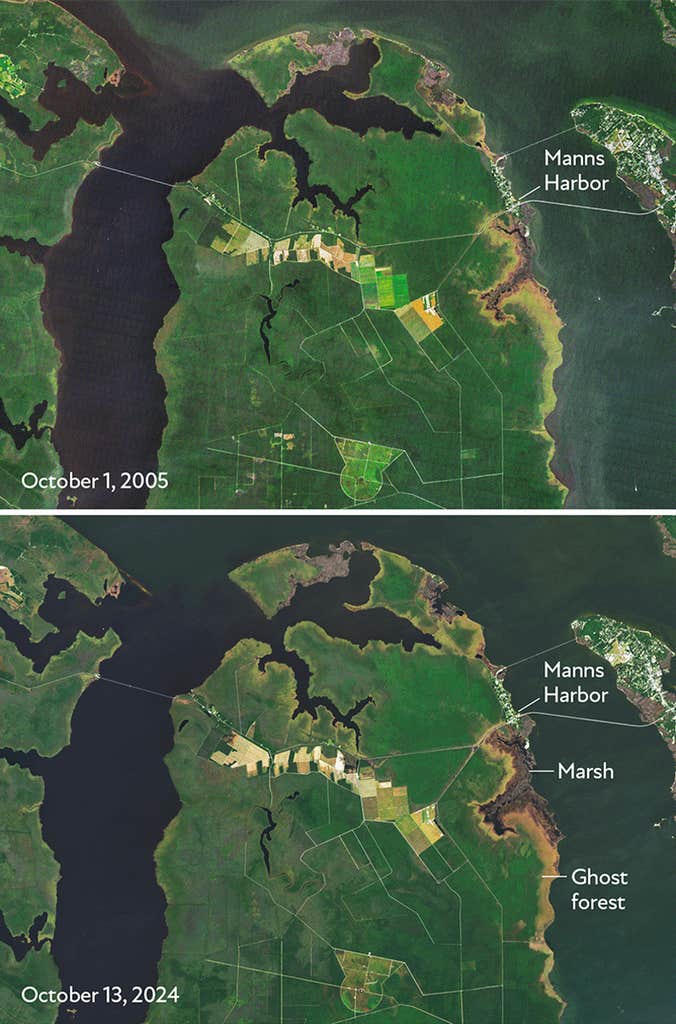Now Reading: Ghost Forests Are Growing
-
01
Ghost Forests Are Growing
Ghost Forests Are Growing

Sign up for the free Nautilus newsletter:
science and culture for people who love beautiful writing.
This article originally appeared in Knowable Magazine.
Like giant bones planted in the earth, clusters of tree trunks, stripped clean of bark, are appearing along the Chesapeake Bay on the United States’ mid-Atlantic coast. They are ghost forests: the haunting remains of what were once stands of cedar and pine. Since the late 19th century, an ever-widening swath of these trees has died along the shore. And they won’t be growing back.
These arboreal graveyards are showing up in places where the land slopes gently into the ocean and where salty water increasingly encroaches. Along the U.S.’s east coast, in pockets of the west coast and elsewhere, saltier soils have killed hundreds of thousands of acres of trees, leaving behind woody skeletons typically surrounded by marsh.
What happens next? That depends. As these dead forests transition, some will become marshes that maintain vital ecosystem services, such as buffering against storms and storing carbon. Others may become home to invasive plants or support no plant life at all—and the ecosystem services will be lost. Researchers are working to understand how this growing shift toward marshes and ghost forests will, on balance, affect coastal ecosystems.
Many of the ghost forests are a consequence of sea level rise, says coastal ecologist Keryn Gedan of George Washington University in Washington, D.C., coauthor of an article on the salinization of coastal ecosystems in the 2025 Annual Review of Marine Science. Rising sea levels can bring more intense storm surges that flood saltwater over the top of soil. Drought and sea level rise can shift the groundwater table along the coast, allowing saltwater to journey farther inland, beneath the forest floor. Trees, deprived of fresh water, are stressed as salt accumulates.
Yet the transition from living forest to marsh isn’t necessarily a tragedy, Gedan says. Marshes are important features of coastal ecosystems, too. And the shift from forest to marsh has happened throughout periods of sea level rise in the past, says Marcelo Ardón, an ecosystem ecologist and biogeochemist at North Carolina State University in Raleigh.

“You would think of these forests and marshes kind of dancing together up and down the coast,” he says.
Marshes provide many ecosystem benefits. They are habitat for birds and crustaceans, such as salt marsh sparrows, marsh wrens, crabs, and mussels. They are also a niche for native salt-tolerant plants, like rushes and certain grasses, which provide food and shelter for animals.
Marshes can also store hefty amounts of carbon from the atmosphere. The plants take in carbon dioxide during photosynthesis, while mucky sediments trap other carbon sources like dead leaves and small creatures. Along coastal rivers in southern Georgia, for example, brackish and salt marshes can sequester more carbon than the tidal forests they are replacing.
Salt marshes also buffer inland ecosystems from storms along the sea, taking the brunt of heavy winds and storm surges, protecting the trees beyond. Recent research suggests that wide marshes help to prevent additional ghost forests by stopping some saltwater from sweeping into the forest.
But not all salt marshes can replace a forest’s aptitude for sucking up carbon. Ardón has been studying the forests of North Carolina’s Albemarle-Pamlico Peninsula. He found that these forests, which host rugged bald cypress, Atlantic white cedar, and a mix of deciduous hardwoods, stored more carbon than the wetlands that are beginning to overtake them.
And marshes don’t always develop as trees die. When forests are inundated too rapidly, mudflats develop instead, and services from both trees and marshes are lost. Sometimes, invasive plant species move in before native marsh plants can take hold.
“When a lot of these forests die back, instead of being replaced with a native salt marsh … what’s actually taking its place is a phragmites marsh,” says forest ecologist Stephanie Stotts of the University of Maryland Eastern Shore in Princess Anne, coauthor of the Annual Review of Marine Science article. One Phragmites subspecies is an invasive reed that rapidly takes over wetland habitats. Native animals aren’t adapted to eat these phragmites, so the reed’s prevalence could affect other creatures, Stotts says.
Many ghost forests are expanding; Estimates suggest that since 1985, 11 percent of forest in the Alligator River National Wildlife Refuge on the Albemarle-Pamlico Peninsula has been converted to marsh; around 150 square miles of forest surrounding the Chesapeake Bay area have transitioned since the mid 1800s. The only way to slow the trend down, Geden says, would be to combat sea level rise and climate change.
It still remains unclear how these coastal transitions will play out and whether, as trees succumb, they will give way to healthy marshes. It takes several decades for trees to die, says Stotts, so the full impact of these forests’ becoming skeletons remains to be seen. “We’re about 50 years behind.” ![]()
This article originally appeared in Knowable Magazine, a nonprofit publication dedicated to making scientific knowledge accessible to all. Sign up for Knowable Magazine’s newsletter.
Lead photo by Will Parson, Chesapeake Bay Program / Flickr
-
Jude Coleman
Posted on
Jude Coleman is an Oregon-based freelance journalist who covers ecology, climate change, and the environment. Read more of her work at judecoleman.com.
Get the Nautilus newsletter
Cutting-edge science, unraveled by the very brightest living thinkers.























